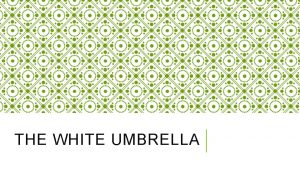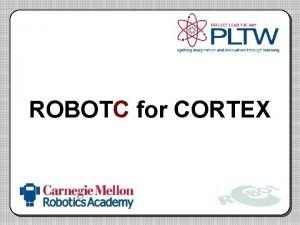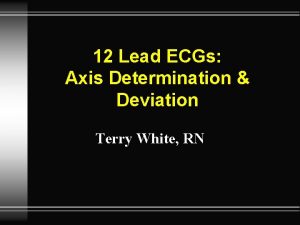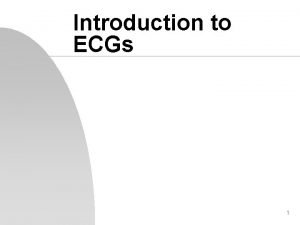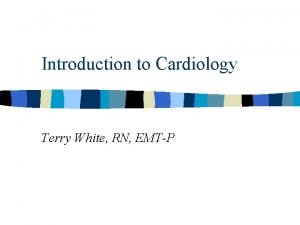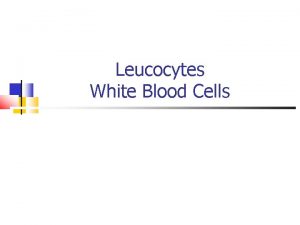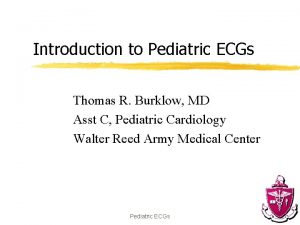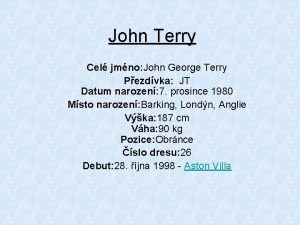Introduction to ECGs Terry White RN 1 Discussion




































- Slides: 36

Introduction to ECGs Terry White, RN 1

Discussion Topics n ECG Monitoring Basics n Standardized Methods & Devices n n Components & Measurements of the ECG Complex ECG Analysis 2

ECG Monitoring 3

ECG Monitoring n n Recording of Electrical Activity Uses Bipolar or Unipolar leads The ECG DOES NOT provide a recording or evaluation of Mechanical Activity!!! 4

ECG Monitoring n Bipolar Leads u 1 positive and 1 negative electrode RA always negative F LL always positive F u Traditional limb leads are examples of these Lead I F Lead III F u Provide a view from a vertical plane 5

ECG Monitoring n Unipolar Leads 1 positive electrode u 1 negative “reference point” u F u calculated by using summation of 2 negative leads Augmented Limb Leads a. VR, a. VF, a. VL F vertical plane F u Precordial or Chest Leads V 1 -V 6 F horizontal plane F 6

ECG Monitoring n Einthoven’s Triangle Each lead “looks” from a different perspective u Can determine the direction of electrical impulses u Upright electrical recording indicates electricity flowing towards the + electrode u F positive deflection 7

Standardized Methods & Devices 8

Standardized Methods & Devices n ECG Paper Device Paper Speed Device Calibration Electrode Placement n Variations Do Exist! n n n 9

Standardized Methods & Devices n ECG Graph Paper u Vertical F 1 axis- voltage small box = 1 mm = 0. 1 m. V u Horizontal F 1 axis - time small box = 1 mm = 0. 04 sec. u Every 5 lines (boxes) are bolded u Horizontal axis - 1 and 3 sec marks 10

Standardized Methods & Devices n ECG Paper Examples u Vertical Axis F No. of mm in 10 small boxes? F No. of small boxes in 2 mm? u Horizontal Axis F No. of seconds in 5 small boxes? F No. of small boxes in 0. 2 second? F No. of small boxes in 1 second? 11

Standardized Methods & Devices n Paper Speed & Calibration u Paper Speed - 25 mm/sec standard u Calibration of Voltage is Automatic u Both Speed and voltage calibration can be changed on most devices 12

Standardized Methods & Devices n Electrode Placement u Standardization improves accuracy of comparison ECGs u 3 Lead and 12 Lead Placement are most common u Assure good conduction gel u Prep area with alcohol prep u Avoid Bone F Large muscles or hairy areas F Limb vs. Chest placement F 13

Standardized Methods & Devices n Electrode Placement u Poor F u placement or preparation Often results in artifact Stray energy from other sources can also lead to poor ECG tracings (noise) F 60 cycle interference 14

Components of the ECG 15

Components of the ECG Complex n Components & Their Representation u P, Q , R, S, T Waves u PR Interval u QRS Interval u ST Segment 16

Components of the ECG Complex n P Wave first upward deflection u represents atrial depolarization u usually 0. 10 seconds or less u usually followed by QRS complex u 17

Components of the ECG Complex n QRS Complex u Composition of 3 Waves Q, R & S F represents ventricular depolarization F much variability F u usually < 0. 12 sec 18

Components of the ECG Complex n Q Wave first negative deflection after P wave u depolarization of septum u not always seen u 19

Components of the ECG Complex n R Wave first positive deflection following P or Q waves u subsequent positive deflections are R’, R”, etc u 20

Components of the ECG Complex n S Wave Negative deflection following R wave u subsequent negative deflections are S’, S”, etc u may be part of QS complex u F absent R wave in aberrant conduction 21

Components of the ECG Complex n PR Interval time impulse takes to move through atria and AV node u from beginning of P wave to next deflection on baseline (beginning of QRS complex) u normally 0. 12 - 0. 2 sec u may be shorter with faster rates u 22

Components of the ECG Complex n QRS Interval time impulse takes to depolarize ventricles u from beginning of Q wave to beginning of ST segment u usually < 0. 12 sec u 23

Components of the ECG Complex n J Point point where QRS complex returns to isoelectric line u beginning of ST segment u critical in measuring ST segment elevation u 24

Components of the ECG Complex n ST Segment early repolarization of ventricles u measured from J point to onset of T wave u elevation or depression may indicate abnormality u 25

Components of the ECG Complex n T Wave repolarization of ventricles u concurrent with end of ventricular systole u 26

ECG Analysis 27

ECG Analysis n n n Rate Rhythm/Regularity QRS Complex P Waves Relationships & Measurements 28

ECG Analysis n Ventricular Rate u Triplicate method F 300 -150 -100 -75 -60 -50 u R-R method F divide 300 by # of large squares between consecutive R waves u 6 Second method F multiply # of R waves in a 6 second strip by 10 u Rate meter unreliable!!! 29

ECG Analysis n Rhythm u Measure R-R intervals across strip u Should find regular distance between R waves u Classification F Regular F Irregular • Regularly irregular • Irregularly irregular 30

ECG Analysis n QRS Complex u Narrow F< 0. 12 seconds (3 small boxes) is normal F indicates supraventricular origin (AV node or above) of pacemaker u Wide F> 0. 12 seconds is wide F indicates ventricular or supraventricular w/aberrant conduction 31

ECG Analysis n P Waves u Present? u Do they all look alike? u Regular interval u Upright or inverted in Lead II? F Upright = atria depolarized from top to bottom F Inverted = atria depolarized from bottom to top 32

ECG Analysis n Relationships/Measurements u PR Interval F Constant? F Less u. P than 0. 20 seconds (1 large bx) to QRS Relationship FP wave before, during or after QRS? F 1 P wave for each 1 QRS? F Regular relationship? 33

ECG Analysis n A monitoring lead can tell you: u How often the myocardium is depolarizing u How regular the depolarization is u How long conduction takes in various areas of the heart u The origin of the impulses that are depolarizing the myocardium 34

ECG Analysis n A monitoring lead can not tell you: u Presence or absence of a myocardial infarction u Axis deviation u Chamber enlargement u Right vs. Left bundle branch blocks u Quality of pumping action u Whether the heart is beating!!! 35

ECG Analysis n n An ECG is a diagnostic tool, NOT a treatment No one was ever cured by an ECG!! Treat the PATIENT not the Monitor!!! 36
 Ecgs
Ecgs Discussion discussion
Discussion discussion The white umbrella discussion questions
The white umbrella discussion questions White sheep white sheep on a blue hill meaning
White sheep white sheep on a blue hill meaning Henry nichols white
Henry nichols white Introduction method result and discussion
Introduction method result and discussion Buddy dean jennings
Buddy dean jennings Terry goh
Terry goh Terry stop
Terry stop Terry richardson predator
Terry richardson predator Terry nazon
Terry nazon Terry fox elementary school
Terry fox elementary school Teori pengambilan keputusan
Teori pengambilan keputusan Terry laster
Terry laster Robotc
Robotc Terry eagleton what is a novel
Terry eagleton what is a novel Kaley jackson
Kaley jackson Michael fellows barrister
Michael fellows barrister Terry hayes md
Terry hayes md Dr terry weaver
Dr terry weaver Finally, it has arrived
Finally, it has arrived The hard way out by terry vaughn subgenre
The hard way out by terry vaughn subgenre Dr terry correll
Dr terry correll Terry tadlock
Terry tadlock Terry biddington
Terry biddington Chapter 26 review questions milady
Chapter 26 review questions milady Types of ergonomics
Types of ergonomics Maggie strus
Maggie strus Ambiguity examples
Ambiguity examples Viessmann manufacturing company
Viessmann manufacturing company Terry fox essay
Terry fox essay The basketball player by terry rudder genre
The basketball player by terry rudder genre Professor hill's strategy development framework
Professor hill's strategy development framework Noman terry towel mills ltd
Noman terry towel mills ltd Terry gage
Terry gage Freddie mercury testamento
Freddie mercury testamento Ken wilber terry killam
Ken wilber terry killam


